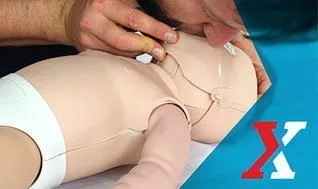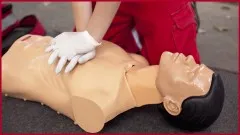
How to Save a Life: Pediatric Advanced Life Support 
This course provides an overview of Pediatric Advanced Life Support (PALS) and teaches participants how to respond to life-threatening emergencies in the pediatric population. It covers advanced emergency interventions, such as performing CPR, using a defibrillator, and administering medications. Participants will gain the skills and knowledge necessary to save a life. ▼
ADVERTISEMENT
Course Feature
![]() Cost:
Cost:
Paid
![]() Provider:
Provider:
Edx
![]() Certificate:
Certificate:
No Information
![]() Language:
Language:
English
![]() Start Date:
Start Date:
Self paced
Course Overview
❗The content presented here is sourced directly from Edx platform. For comprehensive course details, including enrollment information, simply click on the 'Go to class' link on our website.
Updated in [March 06th, 2023]
This course, How to Save a Life: Pediatric Advanced Life Support, is designed to prepare healthcare professionals to respond to life-threatening emergencies in the pediatric population with advanced interventions. Participants will learn how to perform advanced emergency interventions as well as review foundation theories such as basic life support, anatomy and physiology of the heart, resuscitation team, systematic approach, life-threatening issues, medical devices, bradycardia, and tachycardia.
This course is suitable for nurses, paramedics, physicians, medical students, and physician assistants. The course package includes PALS self-assessments and review questions, numerous PALS lectures and video presentations, and a PALS provider manual. Upon completion of the course, participants will be directed to take the certification exam, through National Health Care Provider Solutions.
[Applications]
Upon completion of the Pediatric Advanced Life Support course, participants can apply their knowledge to respond to life-threatening emergencies in the pediatric population with advanced interventions. Participants can also use the course materials to prepare for certification exams, such as the National Health Care Provider Solutions exam. Additionally, the course can be used as a refresher for those already certified in Pediatric Advanced Life Support.
[Career Paths]
The learners of this course can pursue a career in the following job positions:
1. Pediatric Nurse: Pediatric nurses provide care for infants, children, and adolescents. They are responsible for assessing, diagnosing, and treating illnesses and injuries, as well as providing preventive care. They must be knowledgeable in pediatric advanced life support and be able to respond to life-threatening emergencies. The demand for pediatric nurses is expected to grow due to the increasing number of children in need of medical care.
2. Paramedic: Paramedics are responsible for providing emergency medical care to patients in the field. They must be knowledgeable in pediatric advanced life support and be able to respond to life-threatening emergencies. Paramedics must be able to assess a patient’s condition and provide appropriate medical care. The demand for paramedics is expected to grow due to the increasing number of medical emergencies.
3. Physician Assistant: Physician assistants are responsible for providing medical care to patients under the supervision of a physician. They must be knowledgeable in pediatric advanced life support and be able to respond to life-threatening emergencies. Physician assistants must be able to assess a patient’s condition and provide appropriate medical care. The demand for physician assistants is expected to grow due to the increasing number of medical emergencies.
4. Medical Student: Medical students are responsible for learning the fundamentals of medicine and preparing for a career in the medical field. They must be knowledgeable in pediatric advanced life support and be able to respond to life-threatening emergencies. Medical students must be able to assess a patient’s condition and provide appropriate medical care. The demand for medical students is expected to grow due to the increasing number of medical professionals needed in the healthcare industry.
[Education Paths]
Recommended Degree Paths:
1. Bachelor of Science in Nursing: This degree path provides students with the knowledge and skills necessary to become a registered nurse. Students will learn about anatomy and physiology, pharmacology, nutrition, and patient care. They will also gain experience in clinical settings and learn how to provide care to pediatric patients. Additionally, students will learn about the latest trends in pediatric care and how to use advanced technology to provide the best care possible.
2. Master of Science in Nursing: This degree path provides students with the advanced knowledge and skills necessary to become a nurse practitioner. Students will learn about advanced pharmacology, nutrition, and patient care. They will also gain experience in clinical settings and learn how to provide care to pediatric patients. Additionally, students will learn about the latest trends in pediatric care and how to use advanced technology to provide the best care possible.
3. Doctor of Nursing Practice: This degree path provides students with the highest level of knowledge and skills necessary to become a nurse practitioner. Students will learn about advanced pharmacology, nutrition, and patient care. They will also gain experience in clinical settings and learn how to provide care to pediatric patients. Additionally, students will learn about the latest trends in pediatric care and how to use advanced technology to provide the best care possible.
4. Doctor of Philosophy in Nursing: This degree path provides students with the highest level of knowledge and skills necessary to become a nurse researcher. Students will learn about advanced research methods, data analysis, and evidence-based practice. They will also gain experience in clinical settings and learn how to provide care to pediatric patients. Additionally, students will learn about the latest trends in pediatric care and how to use advanced technology to provide the best care possible.
Course Provider

Provider Edx's Stats at AZClass
How to Save a Life: Pediatric Advanced Life Support provides an overview of Pediatric Advanced Life Support and teaches participants how to respond to life-threatening emergencies in the pediatric population. It covers advanced emergency interventions such as performing CPR, using a defibrillator, and administering medication. The curriculum is designed to prepare healthcare professionals to respond to life-threatening emergencies in the pediatric population. Learners will gain an understanding of the anatomy and physiology of the heart, resuscitation team dynamics, a systems approach, life-threatening issues, medical equipment, bradycardia, and tachycardia. This course is ideal for nurses, paramedics, doctors, medical students and physician assistants.
Discussion and Reviews
0.0 (Based on 0 reviews)
Explore Similar Online Courses

Deep Learning With Tensorflow 20 Keras and Python

Making Sense Of Your Personal Finances

Python for Informatics: Exploring Information

Social Network Analysis

Introduction to Systematic Review and Meta-Analysis

The Analytics Edge

DCO042 - Python For Informatics

Causal Diagrams: Draw Your Assumptions Before Your Conclusions

Whole genome sequencing of bacterial genomes - tools and applications

First Aid and Bloodborne Pathogens (BBP)

2 How To Save A Life - Advanced


Start your review of How to Save a Life: Pediatric Advanced Life Support